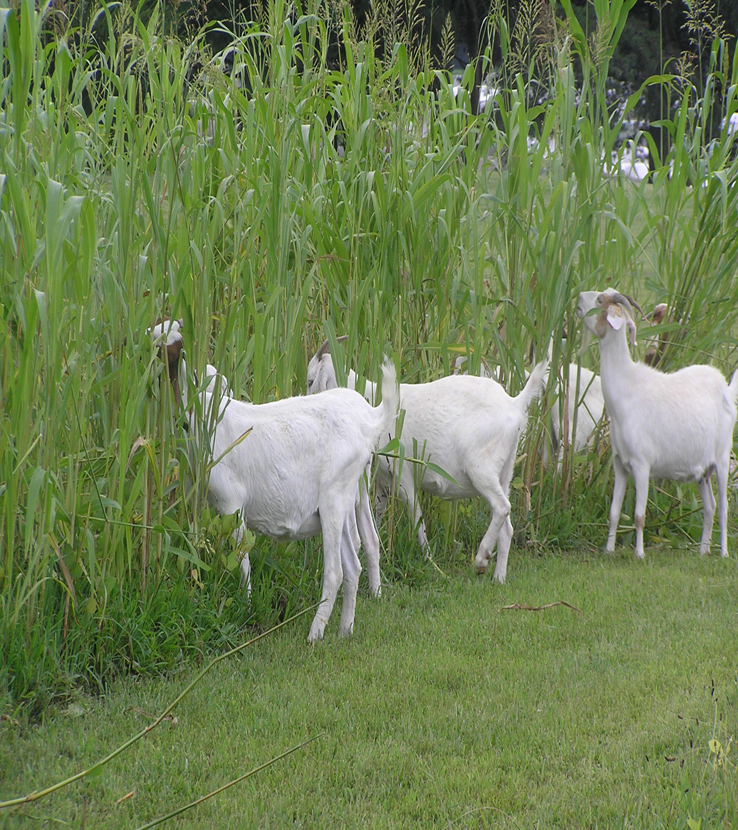Millets
 During the hot summer months adding warm-season annuals to a grazing system can provide a high quality forage when cool-season grasses and legumes decrease in production and quality. One available warm-season annual that can be used in Kentucky is millet. Adding millets can reduce or end the need for feeding stored feeds, overgrazing of cool-season grasses when they are in the “summer slump”, and can increase field stocking density. Millets are small-seeded, fast-growing summer annual grasses used for hay, pasture, and silage. These warm-season annuals are often used as a temporary forage before doing fall pasture renovation. Even though there are several different types of millet, the two most popular in Kentucky are foxtail millet and pearl millet.
During the hot summer months adding warm-season annuals to a grazing system can provide a high quality forage when cool-season grasses and legumes decrease in production and quality. One available warm-season annual that can be used in Kentucky is millet. Adding millets can reduce or end the need for feeding stored feeds, overgrazing of cool-season grasses when they are in the “summer slump”, and can increase field stocking density. Millets are small-seeded, fast-growing summer annual grasses used for hay, pasture, and silage. These warm-season annuals are often used as a temporary forage before doing fall pasture renovation. Even though there are several different types of millet, the two most popular in Kentucky are foxtail millet and pearl millet.
Millets can produce high yielding, good quality forage in a short period of time, without the risk of prussic acid poisoning. Prussic acid can be produce by sudangrass, forage sorghum, and sorghum-sudangrass crosses. Livestock may develop symptoms of prussic acid poisoning when these forages are pastured, or fed as green chop following a drought or frost. Because millets do not produce this toxic compound, they can be a safe alternative to sudangrass pastures.
Foxtail millet is used primarily as a forage crop for silage or hay. Forage varieties can grow to over 40 inches in height, and be cut 75 to 90 days after seeding. Foxtail millet grows shorter than pearl millet and has a finer stem, making it easier to harvest as hay. This annual grass does not regrow after harvest, making it a good crop to use before no-till seeding another crop such as fescue, alfalfa or winter annuals. Foxtail millet has a shallow root system and not ideally suited for grazing.
Pearl millet is better suited for grazing as it is higher yielding and will regrow after grazing. Pearl millet should start to be grazed once it reaches a height of 20 to 24 inches. It will regrow if 8 to 12 inches of stubble is left and you can re-graze it in 10 to 20 days, depending on growing conditions. Dwarf varieties are also available that are leafier and better suited for grazing. Brown midrib varieties of pearl millet are higher in digestibility and feed value due to lower levels of lignin, but they are often lower yielding.
The time of year to plant these crops ranges from May 1 until the end of July. Later plantings reduce the number of harvests of pearl millet and yield potential of both types. Seed can be broadcast and cultipacked, planted with a grain drill into a firm, well-prepared seedbed, or seeded using a no-till drill. The suggested seeding rate for pearl millet is 15 to 20 lbs. per acre when broadcast and 8 to 10 lbs per acre when drilled. Foxtail millet suggested seeding rate is 20 to 30 lbs. per acre when broadcast and 15 to 20 lbs. per acre when drilled.
For optimum yield, lime, phosphorus, and potassium should be applied in accordance to the soil test results. Actual nitrogen should be applied at planting time at a rate of 60 to 100 lbs. per acre, and 40 to 60 lbs. per acre of actual nitrogen may be added after each harvest of pearl millet. Killing weeds prior to planting millet is essential because foxtails and Johnsongrass are extreme competitors. No significant diseases or insect problems occur with millet with the only exception being birds that can damage the grain.
Millets provide a good source of feed for cattle, and can decrease the need for stored feed in the summer months. For more information on which variety may be best in your area, contact your local extension agent.
Categories:
Summer
Species/Varieties


